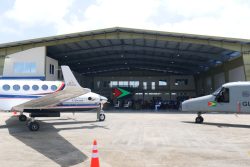Despite continuing to be highly dependent on paper-based processes, the Guyana Lands and Surveys Commission (GLSC) has made significant progress in digitising some of their operations, Chief Executive Officer Trevor Benn says.
Speaking at the Commission’s end-of-year press conference on Monday, Benn said that the continued reliance on paper-based operations remains a major challenge. He cited the high cost and other challenges of transitioning to a digital system but said that fundamental steps have been taken to set the stage for more substantive improvement that will continue in 2019.
He pointed out that the Commission has created a Wide Area Network (WAN) as part of its plan to move to a digital platform and has been linking its regional offices to its head office through the network. According to Benn, the network was developed, tested and implemented between the Head Office on Upper Hadfield Street, D’Urban Backlands, and their regional offices in Regions Two, Three, Six, Nine and Ten. He said that the regional offices are now able to access the centralised accounting system, the Lease Management System and digital records of survey plans that are almost completely digitised.
Work is also ongoing to expand and improve the network and connect the remaining offices in Regions One and Seven.
The Commission can also now offer computerised receipts and invoices generated from the centralised accounting system, to its clients, which Benn said will allow for improved record keeping and accountability.
A web-based intranet application based on the workflow of the internal procurement process was also developed and aims at improving accountability, transparency and efficiency in procurement management. Additionally, another web-based intranet app, a Fixed Assets Management application, was developed during the year to assist in the recording and management of the Commission’s fixed assets. The application also allows for barcode tagging of assets.
A Vehicle Fleet Management application called the GLSC Drive was also developed. It allows for the scheduling and management of the Commission’s fleet of vehicles and drivers. This, Benn said, was developed to better optimise the use of their resources. They have also started compiling a comprehensive vendor database with all of their clients’ transaction information.
“It is our intention to link this database with the Lease Revenue Portfolio to have a more effective and efficient monitoring system in place for all of the Commission’s revenue stream,” Benn said.
Benn also pointed out that they have increased the number of computers for staff to 200, which represents a 27% increase from 2017. Staffers were also trained in Microsoft Office, SAGE AccPac and other software.
Following the signing of a $93 million contract during the second quarter of this year, the GLSC has worked with the national mapping agency of Britain – Ordnance Survey – to upgrade the National Geodetic Network. The agency has since provided technical support in operationalising eight Continuously Operating Reference Stations (CORS) across the country, which, when completed, will result in improved accuracy of surveying while saving time and money.
The execution of the CORS Network project includes the establishment of a fully functional hub or Network Operations Centre at the Commission’s Head Office in Georgetown as well as the reestablishment of communication links to the eight CORS sites at Eclipse Falls, Supenaam, Georgetown, New Amsterdam, Olive Creek, Mahdia, Lethem and Linden.
It will also entail an intensive programme of knowledge transfer and capacity building in the maintenance, operation and use of the CORS Network as well as facilitate wide-ranging stakeholder engagements and exploration of business models for the sustainable use of the nation’s resources.







